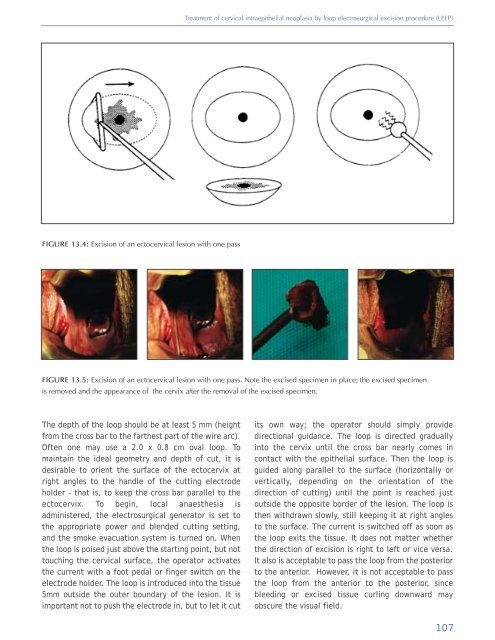Colposcopy and Treatment of Cervical Intraepithelial Neoplasia - RHO
Colposcopy and Treatment of Cervical Intraepithelial Neoplasia - RHO
Colposcopy and Treatment of Cervical Intraepithelial Neoplasia - RHO
You also want an ePaper? Increase the reach of your titles
YUMPU automatically turns print PDFs into web optimized ePapers that Google loves.
<strong>Treatment</strong> <strong>of</strong> cervical intraepithelial neoplasia by loop electrosurgical excision procedure (LEEP)<br />
FIGURE 13.4: Excision <strong>of</strong> an ectocervical lesion with one pass<br />
FIGURE 13.5: Excision <strong>of</strong> an ectocervical lesion with one pass. Note the excised specimen in place; the excised specimen<br />
is removed <strong>and</strong> the appearance <strong>of</strong> the cervix after the removal <strong>of</strong> the excised specimen.<br />
The depth <strong>of</strong> the loop should be at least 5 mm (height<br />
from the cross bar to the farthest part <strong>of</strong> the wire arc).<br />
Often one may use a 2.0 x 0.8 cm oval loop. To<br />
maintain the ideal geometry <strong>and</strong> depth <strong>of</strong> cut, it is<br />
desirable to orient the surface <strong>of</strong> the ectocervix at<br />
right angles to the h<strong>and</strong>le <strong>of</strong> the cutting electrode<br />
holder - that is, to keep the cross bar parallel to the<br />
ectocervix. To begin, local anaesthesia is<br />
administered, the electrosurgical generator is set to<br />
the appropriate power <strong>and</strong> blended cutting setting,<br />
<strong>and</strong> the smoke evacuation system is turned on. When<br />
the loop is poised just above the starting point, but not<br />
touching the cervical surface, the operator activates<br />
the current with a foot pedal or finger switch on the<br />
electrode holder. The loop is introduced into the tissue<br />
5mm outside the outer boundary <strong>of</strong> the lesion. It is<br />
important not to push the electrode in, but to let it cut<br />
its own way; the operator should simply provide<br />
directional guidance. The loop is directed gradually<br />
into the cervix until the cross bar nearly comes in<br />
contact with the epithelial surface. Then the loop is<br />
guided along parallel to the surface (horizontally or<br />
vertically, depending on the orientation <strong>of</strong> the<br />
direction <strong>of</strong> cutting) until the point is reached just<br />
outside the opposite border <strong>of</strong> the lesion. The loop is<br />
then withdrawn slowly, still keeping it at right angles<br />
to the surface. The current is switched <strong>of</strong>f as soon as<br />
the loop exits the tissue. It does not matter whether<br />
the direction <strong>of</strong> excision is right to left or vice versa.<br />
It also is acceptable to pass the loop from the posterior<br />
to the anterior. However, it is not acceptable to pass<br />
the loop from the anterior to the posterior, since<br />
bleeding or excised tissue curling downward may<br />
obscure the visual field.<br />
107
















